#Trump International Hotel Las Vegas
Text
Trump International Hotel, Las Vegas

0 notes
Photo
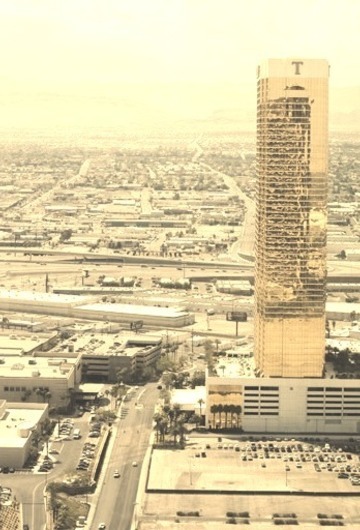
Trump International Hotel, Las Vegas
2 notes
·
View notes
Photo

Trump International Hotel, Las Vegas
0 notes
Photo
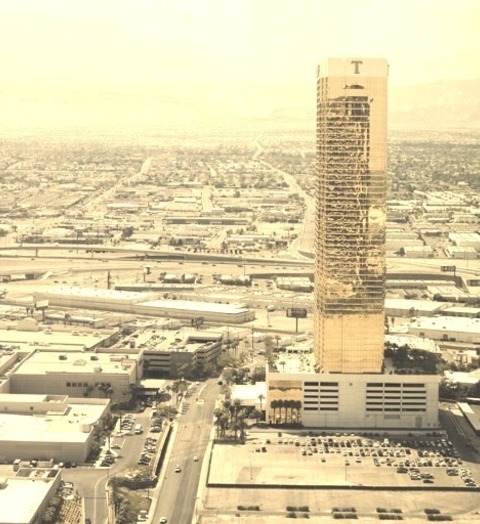
Trump International Hotel, Las Vegas
0 notes
Photo
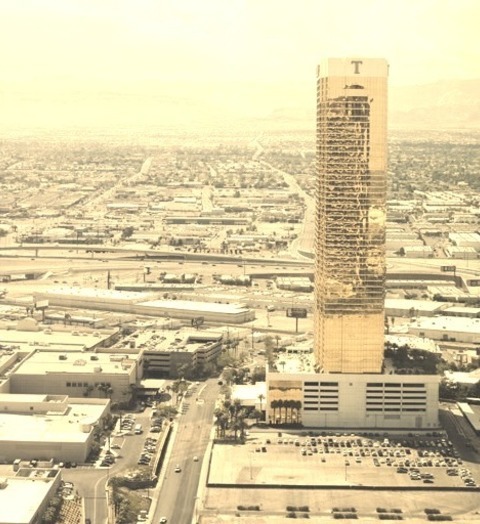
Trump International Hotel, Las Vegas
0 notes
Photo

Trump International Hotel, Las Vegas
1 note
·
View note
Photo

Trump International Hotel, Las Vegas
1 note
·
View note
Text

When Republicans make accusations against Democrats, it's a given that Republicans themselves are deeply guilty of those charges.
Republicans may be terrible at governing, but they are world class when it comes to projection.
Rep. James Comer (R-KY-01) is frantically searching for nonexistent "evidence" to impeach Joe Biden while ignoring Trump businesses getting over $7 million from China, Saudi Arabia, and other countries while in office. What on earth was the Chinese government doing at a Trump property in Las Vegas?

^^^ Did the Democratic Republic of Congo spend $25,171 at the Trump International Hotel in DC so he would stop calling them a "shit-hole country"? 🇨🇩
As for GOP Rep. James Comer, he's a hypocritical multimillionaire twit who is the perfect corrupt MAGA zombie.
The Republican leading the probe of Hunter Biden has his own shell company and complicated friends
#james comer#us house of representatives#ky-01#republicans#projection#gop hypocrisy#trump-china scandal#donald trump#china#saudi arabia#democratic republic of congo#election 2024#john cole
23 notes
·
View notes
Text
Dias 11 a 23
Eu sei, já não escrevo aqui há séculos, mas a vontade tem sido pouca e este já é o segundo rascunho que faço - o primeiro já estava longo e perdi-o totalmente por problemas de wifi. Portanto, um disclaimer - este não vai sair tão bem como a sua primeira versão, mais que não seja pela irritação inerente a ter perdido tudo.
Dizia qualquer coisa como aqui vai um esforço à memória a médio prazo para vos descrever as aventuras da 2ª parte da viagem continental no Oeste dos EUA mas agora será um esforço também à memória a curto prazo do que tinha para lá escrito - um esforço inteiramente dedicado aos 4 fiéis leitores que pediram insistentemente mais um post, este é para vocês (vocês sabem quem são).
O Hawaii ficará para um último post, escrito pelo Kiko, que está a dormir e não pode dizer que não concorda.
LAS VEGAS
Vegas, o que dizer deste parque de diversões para adultos no meio do deserto?
É que é mesmo isso, nada faz adivinhar depois de andar quilómetros e quilómetros desde o Zion até Vegas, em que o cenário é uma auto-estrada com uma faixa única em cada sentido e deserto árido à volta, que exista, de repente, uma cidade daquele nível ali.
Assim do nada, começam fileiras de resorts interligados (e por resorts entenda-se hotel-casino-centro comercial-sala de espectáculos tudo do mesmo espaço), néons, luzes, réplicas miniaturas da Estátua da Liberdade, da Torre Eiffel e dos canais de Veneza com a suas gôndolas, fontes dançantes, rodas-gigantes, cartazes a anunciar concertos, espectáculos, promoções, the world's best mind reader (come find out and be amazed), clubes de strip, palmeiras, multidões, enfim, uma verdadeira loucura.
Vegas é verdadeiramente uma cidade de extravagância e opulência que não deixa ninguém indiferente - you either love it or you hate it.
E é incrível como os filmes nos deixam ideias tão exactas do que se passa lá dentro: o gingão com uma babe de cada lado a pedir que lhe soprem os dados para dar sorte, a amizade transitória entre apostadores e com o dealer se o jogo tiver a correr bem, a intensidade do ambiente em mesas de blackjack e poker com high bids, a população maioritariamente feminina, obesa, de meia-idade que habita a zona das slot machines que enquanto seguram o cigarro numa mão, a outra toca insistentemente no botão de forma passiva sem acreditar muito num destino de fortuna, a free-booze enquanto jogas, as massajadoras ambulantes que prolongam o bem-estar de quem está a jogar, winner winner chicken dinner. Enfim um ambiente contagiante que te impulsiona a jogar e a ficar com um saldo negativo de 60 paus (o Kiko muito surpreendido com o azar, eu preocupada cada vez que ele punha outra nota de 20, a conclusão que com tanta sorte ao amor, era impossível termos no jogo também).

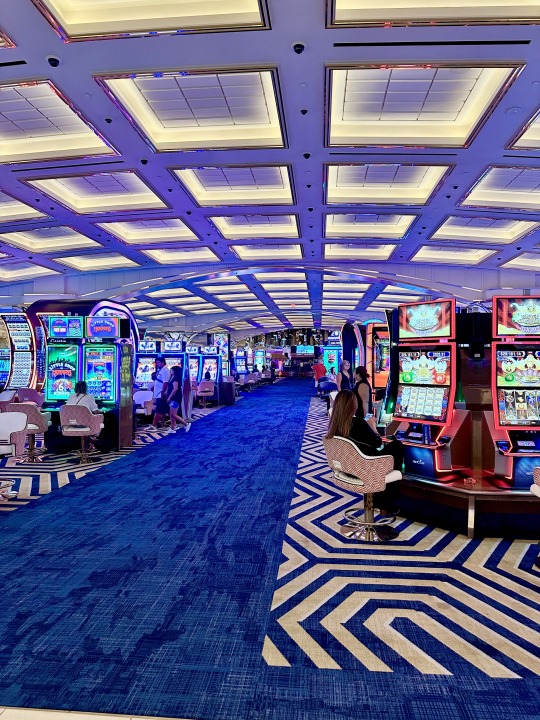

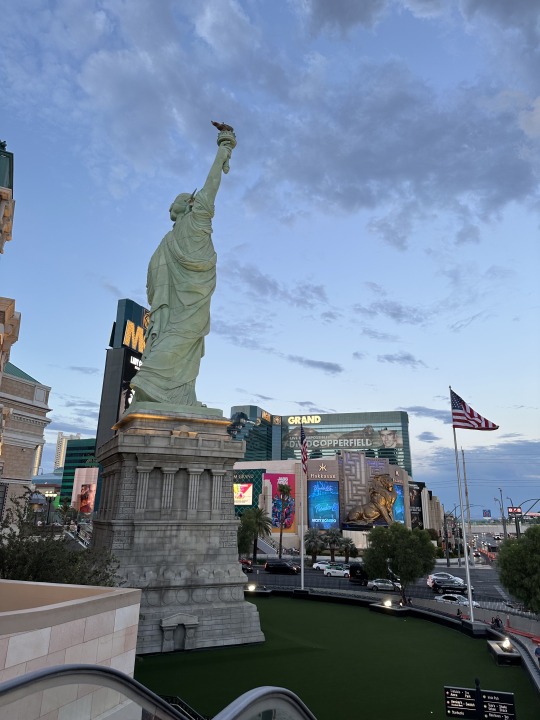


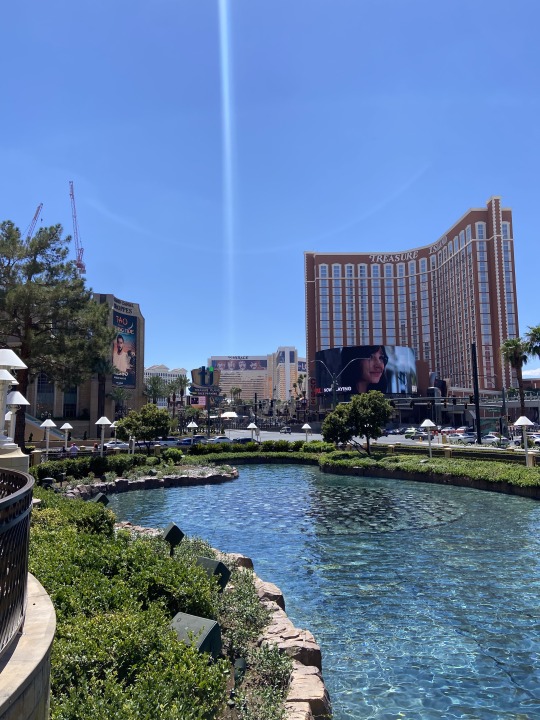
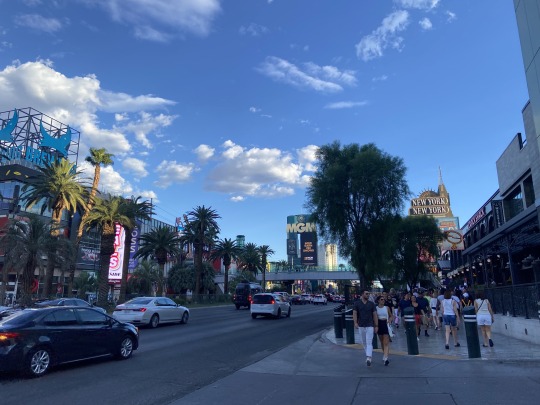
Assim em modo highlights de Vegas:
Embarrassed to say it mas ficamos no Trump International, onde conseguimos um upgrade grátis para um quarto num piso mais alto com vista para toda a strip porque o ciganinho conseguiu rejeitar dois quartos prévios alegando um cheiro esquisito.
Jantámos no Hells Kitchen - parte II do meu presente de 32 anos para o Kiko, arranjada à pressão depois da reacção à viagem de helicópetro- e tenho a dizer que belíssimo bife Wellington tava uma verdadeira delícia. No entanto, é capaz de ter sido o restaurante com pior acústica de sempre que já fomos, às tantas desistimos de falar um com o outro tal era o barulho dos outros, para poupar as nossas gargantas - ai ai Gordon isto não passava no Kitchen Nightmares.

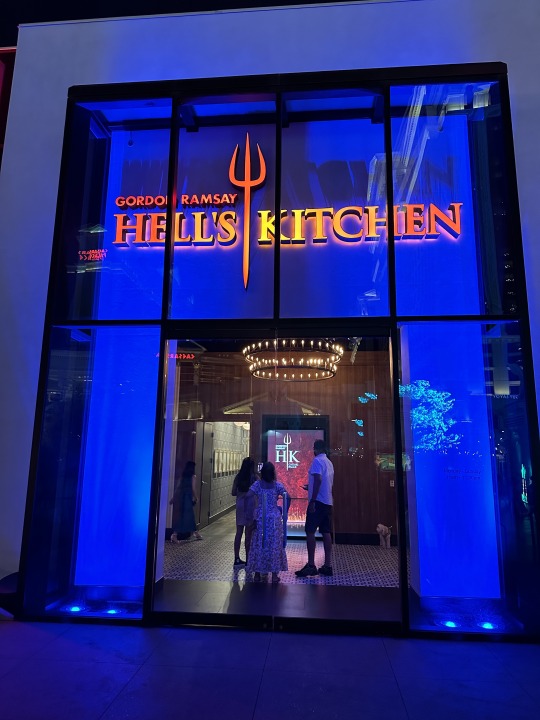
Fomos ver o 69º espectáculo da residência da Katy Perry em Las Vegas, não porque somos particularmente fãs mas porque os bilhetes para a Adele eram 500 dólares. E foi um espectáculo muito divertido, ela é super engraçada, meio quirky e interage imenso com o público e sempre que fazia cenas estranhas dizia "think, you could be at Adele's right now"
Na cidade do pecado e do vale-tudo, na qual existe um restaurante que à entrada tem uma balança porque as pessoas com mais de 156 kg comem sem pagar e tem um cartaz que orgulhosamente diz que já morreram pessoas ali de enfarte durante a refeição, não há como não admirar os contrastes de me ter sido pedido o BI quando pedi um sugar free redbull num bar (para combater a falta de cafeína do café americano deslavado, volta Nespressoo).
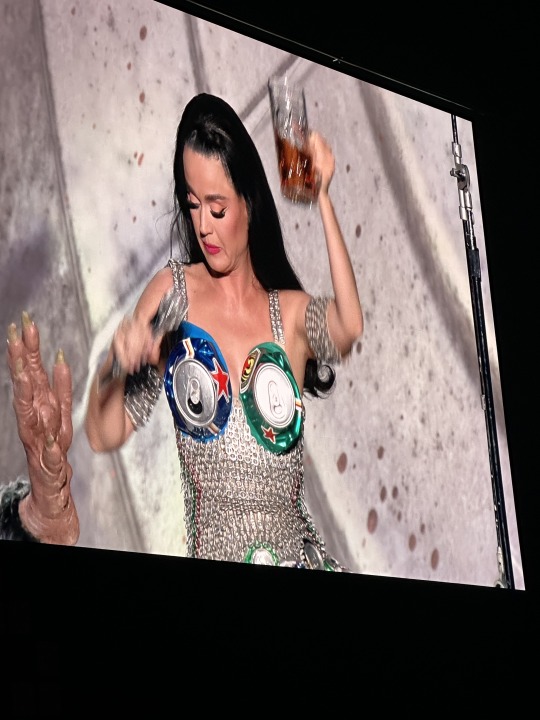
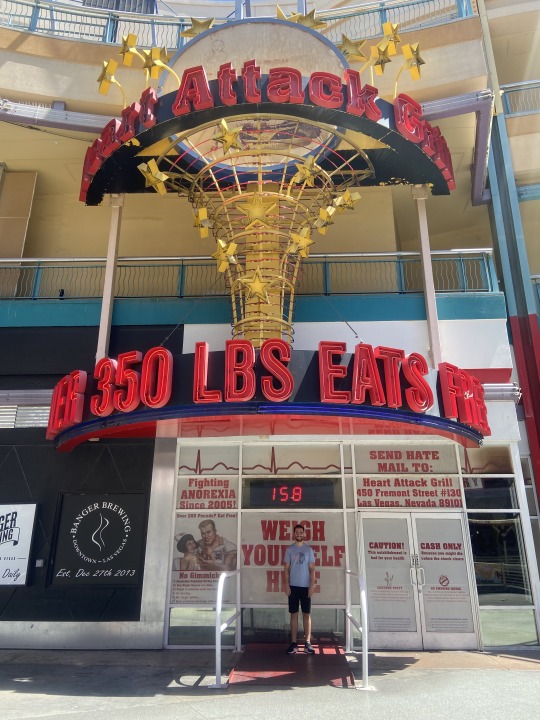
DEATH VALLEY NATIONAL PARK
Acho que o nome diz tudo, mas assim como pedaços de trívia para essas mentes curiosas tenho a oferecer que foi o sítio do mundo onde se registou a temperatura mais alta de sempre (56.7º) e que é o sítio mais seco da América do Norte.
Uma pesquisa rápida do google sobre o Death Valley sugere: can you survive in Death Valley? for how long can you survive in DV? how many deaths does DV have? and so on.
Nós até tivemos sorte que no dia em que visitámos estavam uns míseros 42º, completamente suportável, ainda que parecia que levávamos como que um estalo de bafo cada vez que saíamos do nosso carro confortavelmente condicionado para visitar.
São quilómetros e quilómetros em que não se vê vivalma e em que não existe qualquer sinal de rede. Ainda assim é duma incontornável beleza natural e ficámos contentes de adicioná-lo ao repertório de parques naturais que vimos em western USA, todos tão diferentes e todos tão incrivelmente bonitos.

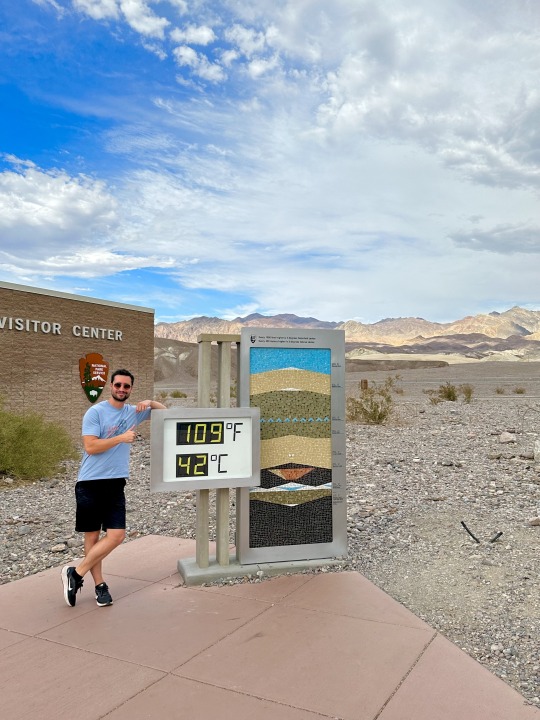
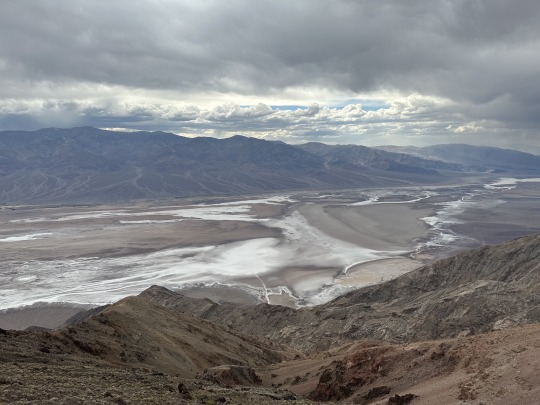





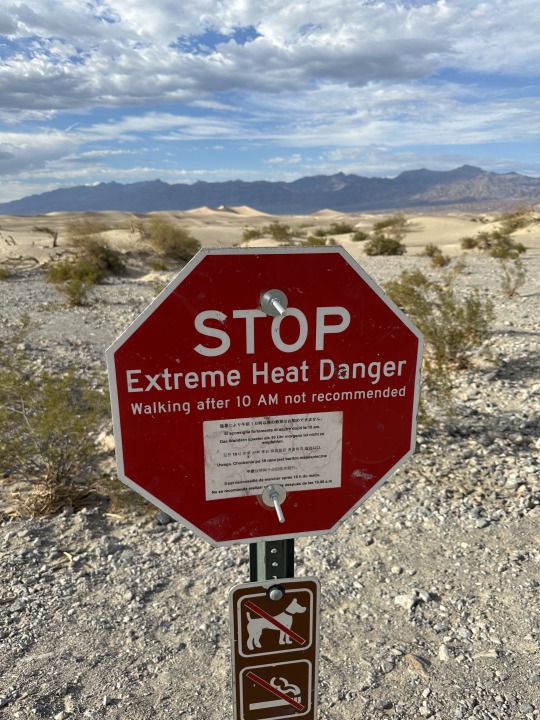


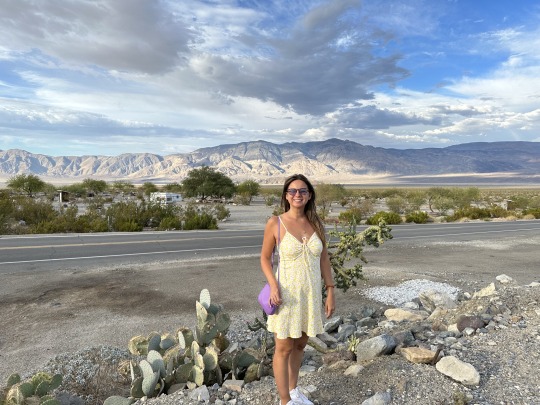

Conseguem sentir o calor pelo vídeo?
Como o limite de 30 fotografias e 1 vídeo por publicação atingido e com receio de perder tudo novamente, publico já este e segue no post seguinte a continuação deste.
8 notes
·
View notes
Text
“I don’t forget where I come from,” Senator Catherine Cortez Masto declared early on Sunday morning, flanked by union workers at the Carpenters International Training Center, in Las Vegas. Dressed in a navy suit with her hair in a sleek bob, the fifty-eight-year-old Democratic senator spoke from a makeshift podium hours after winning reëlection. She invoked her immigrant roots: her paternal grandfather, a veteran of the Second World War who had immigrated to the U.S. from the northern state of Chihuahua, Mexico, and her father, who, in his youth, had parked cars at the Dunes Hotel and went on to lead the local government body that oversees the Strip. “It’s the story of so many Latino families across our state,” Cortez Masto said. “When far-right Republicans said they knew better, I knew we would prove them wrong.” Her words drew chants of “Sí se pudo”—Yes we could.
Cortez Masto’s defeated opponent, Adam Laxalt, who is forty-four, had also campaigned on an appealing origin story—and a familiar last name. After spending five years in the Navy, during which he deployed to Iraq, Laxalt chose a political path, following in the footsteps of his father and grandfather, who were both Republican senators. (From 2015 to 2019, he served as Nevada’s attorney general.) In the weeks leading up to the election, Laxalt and Cortez Masto were virtually tied in the polls. The ballot-counting process, which stretched on for days, initially favored Laxalt, who performed strongly across the state’s rural counties. But, after those results were in, his lead narrowed; mail-in ballots from the counties of Clark and Washoe—Nevada’s largest—broke for Cortez Masto by a margin of two to one. Until Saturday evening, when the Senate race was called, a looming question was whether her support among Latinos would exceed sixty per cent, a requisite in the eyes of many of the state’s Democratic operatives.
“You just can’t win Nevada without Latinos,” Mari Urbina, a senior adviser to the late Senator Harry Reid, told me. Judging by the exit polls, Cortez Masto’s support among Latinos seems to have reached sixty-four per cent. “If these numbers hold once the voter files are updated, Cortez Masto will have outperformed President Biden’s numbers in Nevada with Latinos,” Urbina said.
Cortez Masto is a protégée of Reid, and has followed his example in placing Latinos at the center of her campaign—a tactic that helped Reid clinch his last reëlection, in 2010. Reid was known to spend many Christmas Eves visiting Latino families, but he courted the community year-round. When people questioned his approach, arguing that Latinos were low-turnout voters, he usually responded, “Just you wait.” In 2015, when Reid announced his intention to retire, he anointed Cortez Masto as his successor. The following year, Cortez Masto narrowly won, becoming the first Latina senator in U.S. history. She was dubbed la Senadora at home.
Nevada has more than four hundred thousand eligible Latino voters, almost twenty per cent of the electorate. Over the years, the vast majority of these voters have sided with Democrats, but that support has eroded in recent elections. In 2020, Biden earned roughly sixty-one per cent of the Latino vote, less than Hillary Clinton’s margin four years earlier, as Latinos in Las Vegas surged toward Donald Trump.
Early on in his campaign, Laxalt tried to exploit this trend by zeroing in on Latinos. In the spring of 2020, when the pandemic shut down the Strip and the streets of Las Vegas emptied, the state’s unemployment rate surpassed twenty-eight per cent. In the days before the election, according to AP VoteCast polling, ninety-five per cent of likely Latino voters cited inflation as an important factor; eighty per cent cited crime. Laxalt ran on these twin issues, casting Democrats as responsible for both. He blamed Cortez Masto and Steve Sisolak, Nevada’s Democratic governor, for the economic hit, arguing that the state’s current problems—among them record-high gas prices—could be traced back to their poor decisions.
But Cortez Masto, with the aid of unions she has worked with for years, was able to counter that argument. “The question of who fought for us during the pandemic really matters to us,” Ted Pappageorge, the secretary-treasurer of Nevada’s Culinary Union, told me. Pappageorge represents sixty thousand hospitality workers, mostly Latinos, employed by hotels and casinos in and around Las Vegas. In 2020, ninety-eight per cent of the union’s members lost their jobs. (About a fifth are still unemployed.) Pappageorge told me that Cortez Masto made it a priority for them to receive unemployment benefits, mortgage forbearance, and health care. “She’s been a leader that has been behind us,” he said. “The idea that you’re in the worst health crisis in the last century, which became an economic crisis, but wouldn’t provide health care for folks is just crazy. That’s where a lot of the Republicans were, and the senator was a champion for us on that issue.”
Ultimately, Cortez Masto’s support among the union and the broader Latino community proved to be two of her most powerful political assets. According to Equis, a Latino research firm, Democrats spent more than ten million dollars on Spanish-language ads in Nevada. (Republicans spent three million.) The message that Cortez Masto managed to convey was that she would continue to be a champion for working-class families—a message that resonated with Latinos and helped propel her to unexpected victory. “She was the most vulnerable incumbent, and the entire national G.O.P. apparatus was out to unseat her,” Jon Ralston, a political analyst in Nevada, told me. “She was helped by the Democratic machine built by Harry Reid and by facing a flawed candidate with a much inferior campaign team.”
Last week, I spoke with dozens of Latino voters—few could name any of Laxalt’s accomplishments or concrete proposals. The vast majority identified him simply as the “election denier.” He campaigned alongside Trump and repeatedly raised the spectre of voter fraud—to many, a reminder of Laxalt’s effort to overturn the results of the 2020 election in Nevada. (On Tuesday, Laxalt conceded, blaming “massive ballot harvesting and votes dropped off at dropboxes.”) His affinity for Trump was a rallying cry for Nevada’s immigrant community, which numbers in the hundreds of thousands. Elizabeth, a native of Guatemala, left her home country in 2018 and was separated from her children at the U.S. border. Now in her forties, she works as a cleaner, and told me that she knocked on hundreds of doors ahead of the election, as part of the group Make the Road Action. Elizabeth shared her story with voters, spoke of the sense of fear that continued to haunt her three children, and made a plea to them. “Remember the day when you came to this country,” she told them. “The day when you, too, were an immigrant. Think about those of us who came after you, and please make your voice heard.”
For Latinos, Laxalt came to represent a return to the past. As attorney general, he vehemently opposed the expansion of DACA, and, more recently, called the Supreme Court’s decision to overturn Roe v. Wade a “historic victory.” Across the country, Latinos cited abortion as the second most important issue in this year’s midterms. In Nevada, eighty-six per cent of likely Latino voters surveyed by the Associated Press said that it had factored into their decision to vote. Among those voters, sixty-one per cent cast their ballots for Cortez Masto and thirty-six per cent did so for Laxalt. “It feels like our rights are being jeopardized,” Jesús Vargas, a twenty-five-year-old who also canvassed for Cortez Masto, told me. Over and over, voters told Vargas that they feared the country was caught between extremes. “A lot of people are genuinely scared,” he said. “They worry that we’re regressing as a nation.”
Until precinct-level vote data become available, the extent to which Latinos can be credited for Cortez Masto’s win remains unclear. When her victory speech drew to a close, the crowd dispersed and people in the audience got on with their day. For Diana Valles, the president of the Culinary Union, that meant driving back to her neighborhood to cure ballots—insuring that her community’s votes were duly counted. Valles, who had stood next to Cortez Masto onstage, told me that she could identify with her family’s story. A native of Chihuahua, Valles had moved to Las Vegas in the late eighties and found a job as a guest-room attendant at the Stardust Casino. She raised her children by herself, built a strong reputation as an organizer, and rose through the union’s ranks. She had helped steer the union through the pandemic, and felt that Cortez Masto’s policies saved lives. “She stood up and said, ‘I’m here with you,’ ” Valles said. “That’s one of the things that people never forget: the people who are with you in the hardest times of your life. She’s been with us. She has always been one of us.” ♦
13 notes
·
View notes
Text
phil ruffin
🎰🎲✨ Erhalten Sie 500 Euro und 200 Freispiele, plus einen zusätzlichen Bonus, um Casinospiele mit nur einem Klick zu spielen! ✨🎲🎰
phil ruffin
Phil Ruffin Biografie
Phil Ruffin ist ein bekannter amerikanischer Geschäftsmann und Investor. Er wurde am 14. März 1935 in Wichita, Kansas, geboren. Ruffin begann seine Karriere als Unternehmer, als er Anfang der 1960er Jahre sein erstes Geschäft eröffnete, ein Convenience-Store, der rund um die Uhr geöffnet war. Seitdem hat er sein Imperium weiter ausgebaut und ist heute einer der erfolgreichsten Geschäftsleute in den USA.
Ruffin ist bekannt für seine Investitionen in verschiedene Branchen wie Immobilien, Casinos und Hotels. Eine seiner bekanntesten Investitionen ist der Kauf des Treasure Island Hotels and Casinos in Las Vegas im Jahr 2009. Er erwarb das Hotel für rund 775 Millionen US-Dollar und hat seitdem bedeutende Renovierungen und Verbesserungen vorgenommen, um es zu einem der Top-Ziele in Las Vegas zu machen.
Darüber hinaus ist Ruffin auch Mitinhaber des Trump International Hotel in Las Vegas. Er kaufte das Hotel im Jahr 2008 zusammen mit Donald Trump und spielte eine bedeutende Rolle bei der Entwicklung und Vermarktung des Projekts. Das Trump International Hotel wurde zu einem Symbol für Luxus und Eleganz in Las Vegas.
Abgesehen von seinen Investitionen in die Hotel- und Casino-Branche ist Ruffin auch im Immobiliengeschäft tätig. Er besitzt eine beträchtliche Anzahl von Immobilien in verschiedenen Teilen der USA und ist bekannt für seine Geschäftstätigkeiten im Zusammenhang mit Immobilienentwicklung und -investition.
Phil Ruffin ist ein beeindruckendes Beispiel für Ehrgeiz und unternehmerischen Erfolg. Sein Geschäftssinn und seine Fähigkeit, gute Investitionsentscheidungen zu treffen, haben ihm zu großem Reichtum verholfen. Er ist eine Inspiration für aufstrebende Unternehmer und zeigt, dass mit harter Arbeit und kluger Investition jeder seine Träume verwirklichen kann.
Phil Ruffin ist ein bekannter amerikanischer Unternehmer und Investor, der für sein beträchtliches Vermögen bekannt ist. Mit einem geschätzten Nettovermögen von etwa 3,1 Milliarden US-Dollar zählt er zu den wohlhabendsten Menschen der Welt.
Geboren am 14. März 1935 in Wichita, Kansas, begann Ruffin seine Karriere als junger Unternehmer. Er gründete verschiedene Unternehmen in unterschiedlichen Branchen, darunter Immobilien, Finanzen, Hotels und Casinos. Eine seiner bemerkenswerten Errungenschaften war der Kauf des Treasure Island Hotels und Casinos in Las Vegas im Jahr 2008, für den er einen Betrag von rund 775 Millionen US-Dollar zahlte.
Ruffin besitzt auch das historische Autovermietungsunternehmen "Budget Rent a Car" und ist Partner von Donald Trump bei verschiedenen Immobilienprojekten, darunter das Trump International Hotel in Las Vegas. Sein geschäftlicher Erfolg und sein Vermögen haben ihn zu einer bekannten Persönlichkeit in der Welt der Unternehmer und Investoren gemacht.
Phil Ruffin ist nicht nur ein erfolgreicher Geschäftsmann, sondern auch ein großzügiger Philanthrop. Er hat eine Reihe von Wohltätigkeitsorganisationen und Bildungseinrichtungen unterstützt und dazu beigetragen, die Gemeinschaften zu stärken.
Sein Vermögen ist das Ergebnis harter Arbeit, Geschäftssinn und innovativer Investitionen in verschiedene Branchen. Phil Ruffin ist ein inspirierendes Beispiel dafür, wie harte Arbeit und Entschlossenheit zu großem Erfolg führen können. Mit seinem beeindruckenden Vermögen hat er sich einen Platz unter den reichsten Menschen der Welt verdient.
Insgesamt ist Phil Ruffin nicht nur für sein beträchtliches Vermögen bekannt, sondern auch für seinen Einfluss in der Geschäftswelt und sein Engagement für wohltätige Zwecke. Sein Erfolg ist eine Inspiration für angehende Unternehmer und Investoren, die nach Möglichkeiten suchen, ihr eigenes Vermögen aufzubauen und etwas Gutes zu tun.
Phil Ruffin ist ein erfolgreicher Unternehmer und Investor aus den Vereinigten Staaten. Er wurde am 14. März 1935 in Wichita, Kansas geboren. Ruffin hat eine bemerkenswerte Karriere hinter sich und ist vor allem für seine Investitionen in die Glücksspiel- und Immobilienbranche bekannt.
Seine Karriere begann in den 1960er Jahren, als er eine Kette von Convenience Stores gründete. Im Laufe der Jahre erweiterte er sein Geschäft und investierte in verschiedene Branchen, darunter Hotels, Casinos und Immobilien. Ruffin ist einer der größten Casino-Eigentümer in Las Vegas und besitzt unter anderem das Treasure Island Hotel and Casino.
Sein Erfolg in der Glücksspielbranche hat ihm zu großem Reichtum verholfen. Laut Forbes beträgt sein geschätztes Vermögen derzeit über 2,5 Milliarden US-Dollar. Ruffin ist jedoch nicht nur als Geschäftsmann erfolgreich, sondern auch als Philanthrop bekannt. Er hat einen beträchtlichen Teil seines Vermögens für wohltätige Zwecke gespendet und verschiedene Bildungs- und Gesundheitsinitiativen unterstützt.
Trotz seines hohen Alters ist Phil Ruffin immer noch aktiv im Geschäft. Er ist dafür bekannt, Chancen zu erkennen und mutige Entscheidungen zu treffen. Seine Karriere ist ein Beispiel für harte Arbeit, Ausdauer und unternehmerischen Geist. Ruffin hat bewiesen, dass man mit Entschlossenheit und Geschicklichkeit große Erfolge erzielen kann.
Insgesamt lässt sich sagen, dass Phil Ruffin eine beeindruckende Karriere hinter sich hat. Sein Erfolg in der Glücksspiel- und Immobilienbranche hat ihn zu einem der angesehensten Unternehmer seiner Zeit gemacht. Mit seinem Vermögen setzt er sich zudem für wohltätige Zwecke ein und trägt damit zur Verbesserung der Gemeinschaft bei. Phil Ruffin ist zweifellos ein Vorbild für viele angehende Unternehmer.
Phil Ruffin ist ein amerikanischer Geschäftsmann und Unternehmer, der für seine vielfältigen Unternehmungen bekannt ist. Mit seinem Unternehmensimperium hat er sich zu einem der erfolgreichsten Geschäftsmänner in den USA entwickelt. In diesem Artikel werfen wir einen Blick auf 4 der bedeutendsten Unternehmungen von Phil Ruffin.
Hotel- und Kasinoindustrie:
Phil Ruffin hat große Erfolge in der Hotel- und Kasinoindustrie erzielt. Er ist Besitzer des Treasure Island Hotels and Casinos in Las Vegas, das sich zu einem der bekanntesten und beliebtesten Casinos in der Glücksspielhauptstadt der Welt entwickelt hat. Mit seinem geschäftlichen Gespür hat Ruffin das Treasure Island in ein erstklassiges Hotel- und Unterhaltungsziel verwandelt, das Jahr für Jahr Millionen von Besuchern anzieht.
Ölindustrie:
Ein weiterer wichtiger Bereich von Phil Ruffins Unternehmungen liegt in der Ölindustrie. Ruffin besitzt und betreibt Ölfelder und fördert erfolgreich Erdöl. Sein Engagement in der Ölindustrie hat ihm beträchtlichen Reichtum eingebracht und er ist als einer der bedeutendsten Spieler in diesem Bereich anerkannt.
Immobilien- und Baubranche:
Phil Ruffin hat auch umfangreiche Investitionen in die Immobilien- und Baubranche getätigt. Er ist Besitzer zahlreicher Immobilien, darunter Einkaufszentren, Hotels und Wohnkomplexe. Sein unternehmerisches Geschick und seine Vision haben ihm geholfen, lukrative Projekte zu entwickeln und sowohl im kommerziellen als auch im Wohnimmobiliensektor Erfolg zu haben.
Pferderennsport:
Als leidenschaftlicher Pferdeliebhaber hat Phil Ruffin auch im Pferderennsport investiert. Er besitzt und trainiert Rennpferde von Weltklasse und nimmt regelmäßig an renommierten Pferderennen teil. Ruffin ist bekannt für seine Wettbewerbsfähigkeit und seine Hingabe zu diesem Sport, was ihm auch finanziellen Erfolg im Bereich der Pferdewetten eingebracht hat.
Phil Ruffin ist ein beeindruckendes Beispiel für einen erfolgreichen Unternehmer, der durch seine vielfältigen Unternehmungen große Erfolge erzielt hat. Sein Geschäftssinn und seine Entschlossenheit haben ihn zu einem der bekanntesten Unternehmer in den USA gemacht und dienen vielen als Inspiration.
Phil Ruffin, ein bekannter amerikanischer Geschäftsmann und Immobilieninvestor, hat im Laufe seiner Karriere beeindruckende Erfolge erzielt. Hier sind fünf seiner herausragenden Leistungen:
Kauf des Treasure Island Hotels and Casinos: 2009 erwarb Phil Ruffin das Treasure Island Hotel and Casino in Las Vegas. Dieser Schritt war ein Meilenstein in seiner Karriere, da es sich um ein prestigeträchtiges Hotel und Casino handelt. Mit diesem Kauf festigte er seinen Namen als erfahrener Immobilieninvestor und Unternehmer.
Erfolgreiche Zusammenarbeit mit Donald Trump: Phil Ruffin hat eine enge Geschäftsbeziehung mit dem ehemaligen US-Präsidenten Donald Trump aufgebaut. Gemeinsam haben sie das Trump International Hotel in Las Vegas entwickelt. Diese Partnerschaft hat Ruffins Ruf als erfolgreicher Geschäftsmann weiter gestärkt.
Besitz mehrerer Immobilien: Ruffin besitzt nicht nur das Treasure Island Hotel and Casino, sondern auch andere Immobilien sowohl in den USA als auch international. Er hat eine beachtliche Anzahl von Immobilieninvestitionen erfolgreich umgesetzt und dadurch sein Vermögen erheblich erhöht.
Investitionen in diverse Branchen: Phil Ruffin ist nicht nur im Immobiliengeschäft tätig, sondern hat auch in verschiedenen anderen Branchen investiert. Dazu gehören unter anderem der Energie- und der Einzelhandelssektor. Sein breit gefächertes Portfolio zeugt von seinem strategischen Geschäftssinn und seiner Fähigkeit, Chancen zu erkennen.
Wohltätige Spenden: Neben seinen geschäftlichen Erfolgen hat Phil Ruffin auch einen bedeutenden Beitrag zur Gesellschaft geleistet. Er hat großzügige Spenden an wohltätige Organisationen und Bildungseinrichtungen geleistet. Sein Engagement für das Gemeinwohl unterstreicht seine philanthropische Seite und macht ihn zu einem angesehenen Mitglied der Gesellschaft.
Phil Ruffin hat im Laufe seiner Karriere eine beeindruckende Erfolgsgeschichte geschrieben. Sein Geschäftssinn, sein Engagement für wohltätige Zwecke und seine Investitionen in verschiedene Branchen haben ihn zu einem prominente Persönlichkeit gemacht, die in der Geschäftswelt anerkannt wird.
0 notes
Text
China tops foreign spenders at Trump businesses during his presidency, report reveals – live
0 notes
Text
Trumped: the multi-million-dollar lawsuit over Toronto’s most controversial new condo-hotel
The Trump tower, downtown’s tallest new condo-hotel, is a monument to excess. And, like its tycoon namesake, it’s surrounded by controversy: 38 investors are suing the hotel for millions. Lessons from a post-crash real estate market

In the city’s new five-star hotel landscape, the Ritz represents elegant European classicism, the Shangri-La cool, Asian chic, and the Trump unfettered American pomp. Like its loud-mouthed namesake, the Trump is brash, proud and full of bluster. Stock, the hotel’s restaurant and bar, is outfitted with shiny tufted black leather seating and silver accents. Its lobby, a shimmering expanse of marble and mirrors, seems sprung, fully formed, from the imagination of Joan Collins.
The hotel’s developer, Talon International, is run by Val Levitan and Alex Shnaider, two Russian-Canadian entrepreneurs. Levitan made his fortune manufacturing slot machines and creating bank note validation technology, and Shnaider earned his in the post-glasnost steel trade. The Trump is their first Toronto real estate venture. In 2002, during a meeting in Shnaider’s office at Dufferin and Finch, they agreed on a plan to build the city’s biggest, fanciest, five-starriest hotel. They both travel frequently for work and agreed that Toronto’s hotels lacked the quality of the ones they stayed at in London, New York and Moscow. Back then, Toronto’s swankiest option was the old Four Seasons, a dour brutalist tower in Yorkville. But the city was emerging as a major North American financial centre, a place where serious players were coming to do big international deals. These titans were in need of boardrooms in which to meet, bloody steaks to consume, and high-thread-count sheets to sleep between.
In 2004, Talon bought a site at the corner of Bay and Adelaide for $27.4 million. The location was perfect—smack in the centre of the business district. This was before the cultural revitalization of the city’s downtown core, but Levitan and Shnaider could see the signs: the revamping of the Bay’s flagship department store, the plans for the new Bell Lightbox, not to mention a phalanx of condos and restaurants springing up in the city centre. By the time the hotel was completed, it would be the anchor point of a tourist-friendly downtown.
The luxury hotel required a famous brand, which is how the pair ended up approaching Donald Trump. At the time, Trump’s reality show The Apprentice was riding high in the ratings, and the Trump brand was associated with luxury, success and business prowess, not with headline-making Twitter spats and an aborted Republican leadership bid. They worked out a deal to license the Trump name.
They planned a 65-storey mixed-use building consisting of a restaurant and bar, a day spa, 118 condos—some as large as 4,400 square feet and selling for up to $9.1 million—and 261 “condo-hotel suites,” traditional hotel rooms that Talon intended to sell as residential real estate investments. The condo-hotel set-up was unusual in Toronto. It’s an attractive model for developers because it allows them to raise capital up front from investors.
Donald Trump is a shareholder in other Trump developments in Chicago, New York and Las Vegas, but not in Toronto. The hotel would bear his name and his style, and an affiliate of his management company would run the day-to-day hotel service. According to the early marketing brochures, it would be a model for “Manhattan-style luxury living in Toronto.”

By the time the Trump opened in 2012, ten years after the plan was hatched and more than two years later than originally scheduled, the financial climate had, of course, drastically changed. The hotel now felt like a throwback to a cockier, pre-recession era, back when hedge fund managers ruled the world and Bernie Madoff was a respected financial guru. A group of buyers now regret their investment in the building, and millions of dollars in deals between them and Talon are on the verge of collapsing. The group claims their condo-hotel units often sit empty, and they’ve launched a series of lawsuits alleging the Trump sales team misrepresented how much profit they’d make. The defendants say the lawsuits have no merit, that no misrepresentations were made. The claims have yet to be heard in court.
The Trump investors believed they’d bought into a get-rich-quick scheme. How did something so promising go so wrong?
Before there was the Trump Tower, there was the Trump tower sales office, a glass-fronted box that stood on the same prime corner from which the hotel would eventually rise. A polished young sales team sold a steady stream of units, over the phone, online and in person, to a diverse cross-section of buyers—including elderly Korean pensioners, wealthy Nigerians and a now-defunct U.K. company called WorldWide Properties, which bought four floors of hotel units with the intention of flipping them.
When the Trump broke ground, half of the residential condos had sold, as had 191 of the condo-hotel units, which ranged in price from $736,000 to $3.8 million. The suites could be rented out as part of the hotel, providing extra income to buyers. In the Trump system, occupancies are organized in a strict, computerized rotation, which ensures that the least rented room jumps to the front of the queue. The hotel charges service fees for maintenance (linens, towels, cleaning, etc.) and management, but the rest of the rental profit goes to the owner of the room. The promotional material declared that “investing in hotel suites is a trend that’s sweeping the United States… The reason? Great cash flows, no concern for maintenance and reasonable cash requirements as a down payment. Leverage is key, especially in these times of low interest rates.”
0 notes
Text
Trumped: the multi-million-dollar lawsuit over Toronto’s most controversial new condo-hotel
The Trump tower, downtown’s tallest new condo-hotel, is a monument to excess. And, like its tycoon namesake, it’s surrounded by controversy: 38 investors are suing the hotel for millions. Lessons from a post-crash real estate market

In the city’s new five-star hotel landscape, the Ritz represents elegant European classicism, the Shangri-La cool, Asian chic, and the Trump unfettered American pomp. Like its loud-mouthed namesake, the Trump is brash, proud and full of bluster. Stock, the hotel’s restaurant and bar, is outfitted with shiny tufted black leather seating and silver accents. Its lobby, a shimmering expanse of marble and mirrors, seems sprung, fully formed, from the imagination of Joan Collins.
The hotel’s developer, Talon International, is run by Val Levitan and Alex Shnaider, two Russian-Canadian entrepreneurs. Levitan made his fortune manufacturing slot machines and creating bank note validation technology, and Shnaider earned his in the post-glasnost steel trade. The Trump is their first Toronto real estate venture. In 2002, during a meeting in Shnaider’s office at Dufferin and Finch, they agreed on a plan to build the city’s biggest, fanciest, five-starriest hotel. They both travel frequently for work and agreed that Toronto’s hotels lacked the quality of the ones they stayed at in London, New York and Moscow. Back then, Toronto’s swankiest option was the old Four Seasons, a dour brutalist tower in Yorkville. But the city was emerging as a major North American financial centre, a place where serious players were coming to do big international deals. These titans were in need of boardrooms in which to meet, bloody steaks to consume, and high-thread-count sheets to sleep between.
In 2004, Talon bought a site at the corner of Bay and Adelaide for $27.4 million. The location was perfect—smack in the centre of the business district. This was before the cultural revitalization of the city’s downtown core, but Levitan and Shnaider could see the signs: the revamping of the Bay’s flagship department store, the plans for the new Bell Lightbox, not to mention a phalanx of condos and restaurants springing up in the city centre. By the time the hotel was completed, it would be the anchor point of a tourist-friendly downtown.
The luxury hotel required a famous brand, which is how the pair ended up approaching Donald Trump. At the time, Trump’s reality show The Apprentice was riding high in the ratings, and the Trump brand was associated with luxury, success and business prowess, not with headline-making Twitter spats and an aborted Republican leadership bid. They worked out a deal to license the Trump name.
They planned a 65-storey mixed-use building consisting of a restaurant and bar, a day spa, 118 condos—some as large as 4,400 square feet and selling for up to $9.1 million—and 261 “condo-hotel suites,” traditional hotel rooms that Talon intended to sell as residential real estate investments. The condo-hotel set-up was unusual in Toronto. It’s an attractive model for developers because it allows them to raise capital up front from investors.
Donald Trump is a shareholder in other Trump developments in Chicago, New York and Las Vegas, but not in Toronto. The hotel would bear his name and his style, and an affiliate of his management company would run the day-to-day hotel service. According to the early marketing brochures, it would be a model for “Manhattan-style luxury living in Toronto.”
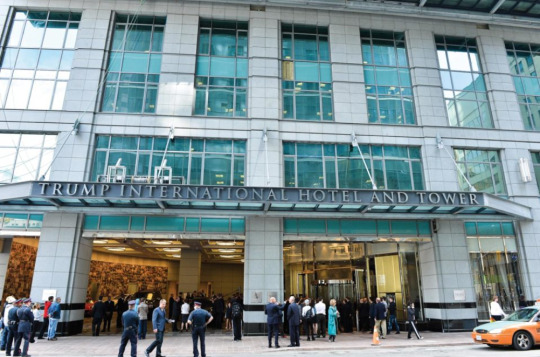
By the time the Trump opened in 2012, ten years after the plan was hatched and more than two years later than originally scheduled, the financial climate had, of course, drastically changed. The hotel now felt like a throwback to a cockier, pre-recession era, back when hedge fund managers ruled the world and Bernie Madoff was a respected financial guru. A group of buyers now regret their investment in the building, and millions of dollars in deals between them and Talon are on the verge of collapsing. The group claims their condo-hotel units often sit empty, and they’ve launched a series of lawsuits alleging the Trump sales team misrepresented how much profit they’d make. The defendants say the lawsuits have no merit, that no misrepresentations were made. The claims have yet to be heard in court.
The Trump investors believed they’d bought into a get-rich-quick scheme. How did something so promising go so wrong?
Before there was the Trump Tower, there was the Trump tower sales office, a glass-fronted box that stood on the same prime corner from which the hotel would eventually rise. A polished young sales team sold a steady stream of units, over the phone, online and in person, to a diverse cross-section of buyers—including elderly Korean pensioners, wealthy Nigerians and a now-defunct U.K. company called WorldWide Properties, which bought four floors of hotel units with the intention of flipping them.
When the Trump broke ground, half of the residential condos had sold, as had 191 of the condo-hotel units, which ranged in price from $736,000 to $3.8 million. The suites could be rented out as part of the hotel, providing extra income to buyers. In the Trump system, occupancies are organized in a strict, computerized rotation, which ensures that the least rented room jumps to the front of the queue. The hotel charges service fees for maintenance (linens, towels, cleaning, etc.) and management, but the rest of the rental profit goes to the owner of the room. The promotional material declared that “investing in hotel suites is a trend that’s sweeping the United States… The reason? Great cash flows, no concern for maintenance and reasonable cash requirements as a down payment. Leverage is key, especially in these times of low interest rates.”
Promotions featured an airbrushed picture of Trump, along with a personal endorsement: “We’re going to do something very special in Toronto.” Trump himself, the ad said, “has an undeniably keen eye for a deal.” The ad neglected to mention that Trump wasn’t the project’s developer, just its smiling face.
Sarbjit Singh, a 49-year-old warehouse supervisor from Milton, was one of the early buyers. Singh first heard about the Trump in October 2006 from a real estate agent who told him it was a great investment opportunity. He and his wife, Kimberly, had recently bought a house and just had their second daughter. He didn’t have the money to buy another property. “I was only making between $50,000 and $60,000 a year,” he says. “I’m a regular person, not rich.”
But the prospect of getting his own piece of Trump magic proved too tempting. He claims the agents at the Trump sales centre told him he couldn’t possibly lose money since the “absolute worst case scenario” was that the hotel ended up at 55 per cent occupancy, and even then the projected returns were healthy. “I asked them a long list of questions,” he recalls. Who was going to arrange the mortgages? What would the interest rate be? Would the property be categorized as commercial or residential (commercial properties come with much higher interest rates). He alleges the sales associate assured him he had nothing to worry about. According to Singh, they said Talon was already working on financing with lenders, and it would all go smoothly. The units would qualify for residential mortgages. Singh then asked at what point he could flip the unit, and the agent told him directly after closing. “You’ll make a lot of money,” he remembers the agent telling him. “Even if you don’t sell, you’ll be making lots of money from the reservation program.”
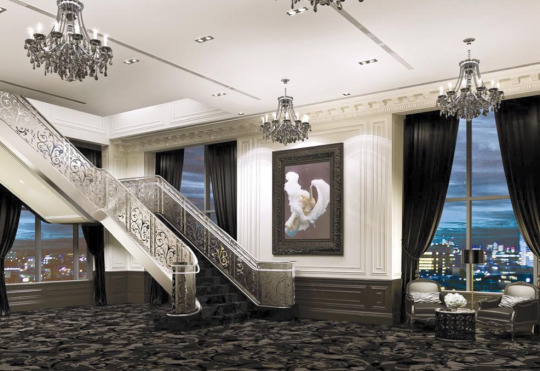
Armed with Talon’s projection sheet, his head dancing with trust funds for his daughters, Singh went to his mother and father, who are retired and living on a pension. He convinced them to take out a $150,000 line of credit on their house, which they owned outright, so he could put down a deposit of $173,400 on an $869,000 suite. He believed, like many other investors I spoke to, that he was buying a piece of real estate directly from Donald Trump and that he couldn’t lose. “I bought it on the strength of his name alone. He’s Donald Trump—hotels and real estate are his business, not mine. I trusted that it would work.”
Construction of the Trump Tower got off to an inauspicious start. It took two years to receive planning permission from the city, and there were more delays after Talon broke ground in late 2007. Because of the site’s small footprint—15,000 square feet—only one crane could be employed at a time. Shnaider admitted it was a bit of a nightmare. “I wouldn’t do such a project again in Toronto,” he said.
More significantly for investors, the economic reality changed. As Levitan put it, “It was a very complicated project that became delayed, and in that time the economy fell apart. How can I control that?” In the new market, the projection sheets Talon had distributed with the initial sales package weren’t worth the creamy stationery they were printed on.
In March 2012, Sarbjit Singh took possession of his unit and started paying monthly fees of $8,207, which covered realty taxes, common fees and interest. He expected his rental profits to more than offset the fees, but when the first revenue statements came in, he knew something was wrong: in four months, his unit had been rented 49 times—roughly a 40 per cent occupancy rate and lower than the “absolute worst case scenario” the agent had discussed with him. Singh’s room was running at a loss. When he called hotel management, they told him the bad news: because of the dampened hotel market, they’d been renting his room out at a discounted rate. (Rooms at the Trump that were forecast to cost $550 to $600 per night have been available for $400 on Expedia.) Singh was losing approximately $5,000 a month.
His problems didn’t end there. He visited several major banks and was told the property was commercial, not residential, and thus he’d need a commercial mortgage, for which he’d need to put 50 per cent down—money he didn’t have. Even if he could find the down payment, the commercial interest rates would raise his mortgage payments beyond what he could afford to carry.
Last November, Singh ran out of reserve cash. He stopped paying his fees and is now working in the evenings and on weekends in an effort to pay his parents’ line of credit. He recently missed a mortgage payment. He has no idea how he’ll get out of debt.
Singh retained the Toronto law firm Heydary Hamilton last November and filed a suit against the developers. Another 37 buyers have also filed suits. A Heydary lawyer named Mitchell Wine, one of the team of 14 lawyers and articling students working on the Trump cases, told me purchasers and representatives of more than 100 units have contacted his office. The firm has filed statements of claim detailing each of the investors’ stories and accusing Talon and other named parties of misrepresentation, breaches of the Ontario Securities Act, breach of contract, breach of the Condominium Act and conspiracy. Each claimant is asking for well over a million dollars in damages, plus their deposit money back with interest. Pleadings are being finalized, and preliminary motions were scheduled to be heard just after this issue went to press. In response, Talon is seeking to have the action by investors dismissed.
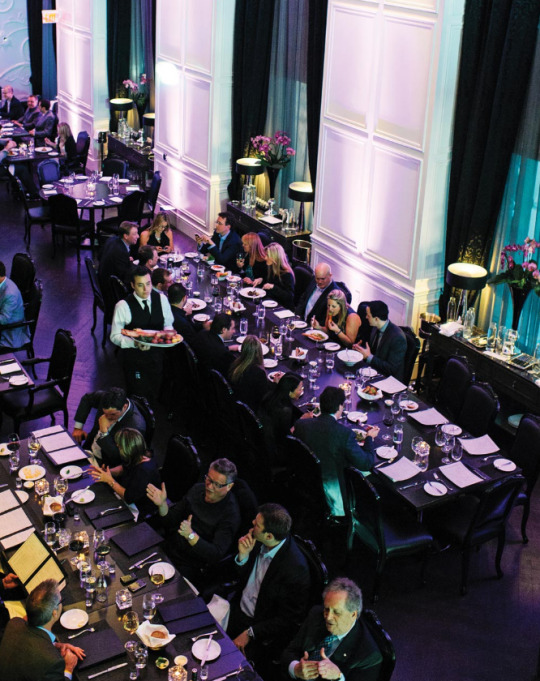
The investors’ suits name Trump Toronto Hotel Management Group and Talon International Inc., as well as Trump, Shnaider and Levitan personally. They allege that the defendants misled investors about the units by providing financial projections that overstated how much they would earn, and by understating expenses (such as occupancy fees). According to the investors’ statements of claim, Talon breached the Ontario Securities Act by selling the units as investment products.
The plaintiffs’ cases centre on a 2004 OSC ruling, which required Talon to market the units as mainly for occupancy, not as investments. Talon was also prohibited from forecasting or guaranteeing profits from the reservation program. And yet, included in the Trump’s original sales package are several charts entitled Estimated Return on Investment, which show detailed breakdowns of the income buyers could expect from their condo-hotel suites. They describe projected common expense fees, housekeeping expenses, estimated taxes and a mortgage projected at six per cent interest. The rental income, in turn, is projected at hotel occupancy rates of 75, 65 and 55 per cent.
Late last year, the OSC investigated the Trump deal to determine whether regulatory action was needed. They met with purchasers and Talon’s lawyers, read over all the documents, and in early December announced they would not be pursuing regulatory action on the matter. When I asked for an explanation, the OSC refused to provide one. The investors’ suits will proceed regardless of the December decision.
The fact is, Talon did warn the Trump buyers about the risks involved in buying condo-hotel units in its disclosure. “A real estate investment is, by its nature, speculative,” the document states. “If a purchaser is purchasing the real estate as an investment, the purchaser should be aware that this investment has not only the usual risks when purchasing real estate, but also those risks that are inherent to the nature of real estate securities.”
A disclaimer in the Trump disclosure lists a series of variables, many of which might seem alarmist if they hadn’t come to pass. These include, but are not limited to, “cyclical downturns arising from real changes in general and local economic conditions; varying levels of demand for rooms and related services caused by changes in travel patterns; the financial condition of the airline industry and the resulting impact on air travel…contagious illness outbreaks, natural disasters, extreme weather conditions, labour shortages, work stoppages or disputes.” There is also a clause, as required by the Condominium Act, stating that each buyer, upon receiving and reading the disclosure document, has 10 days to back out of the deal. According to Levitan, five people did just that.
Investors like Singh claim they didn’t take the warnings about risks seriously because they’d been completely convinced that the investment was a sure bet. It’s a bit like your trusted GP prescribing you a medication and then rattling off the side effects in a super-fast radio ad voice as you leave the office. If what these buyers say is true, the Trump sales team underplayed the risks and overplayed the benefits of buying their condo-hotel units. But sales pitches are hyperbolic by design.
Talon’s statement of defence denies all wrongdoing, including the allegations of misrepresentation and breaching an OSC ruling, and demands the investors forfeit their deposits and pay individual damages of $750,000 each. Levitan says they have a good case for further damages, due to all the bad press the case has received, but they are still “hoping for an amicable solution.”
In Talon’s specific response to Singh’s claim, the company denies that the Trump sales agents promised he could get a residential mortgage or guaranteed a rate of return from the reservation program. It also denies that any promotional material he received breached the OSC ruling. In Levitan’s view, the buyers’ lawsuits are purely opportunistic and won’t stand up in court. Normally, if buyers want to walk away from a deal, a developer will buy back their investment. But the Trump units were sold at the peak of the market. As Levitan points out, “Everything has changed.” Given this reality, Talon is not eager to buy back the units it sold off for millions in the middle of the condo boom. That’s how people—and developers—make money: buying low and selling high. Why should they absorb the cost of others’ bad financial timing?
The group of disgruntled buyers, Levitan says, is primarily composed of people who did not attempt to rescind the deal in the allotted time frame, then realized they couldn’t secure financing and decided to file suit. The fact that they don’t have the money to close only shows that they probably shouldn’t have taken the risk in the first place. “Instead they claim that they thought they were buying from Donald Trump and we promised them a rose garden,” Levitan says with a snort. “It’s a pure form of extortion.”
He says he’s sad for the people who got in over their heads. He’d prefer “the world to be a rosy place in which people are always happy with their investments,” but that didn’t happen with Trump. “So what am I supposed to do?” he says. “Go to the drywall contractor and say, ‘Sorry, but I can’t pay you because 30 investors aren’t paying me?’ ”
Raymond Diep, a Toronto real estate lawyer at the firm Aaron & Aaron, which handled a number of the Trump condo-hotel closings, said his firm’s clients weren’t happy about losing money each month, but they chose to take a long-term view on the investment. “They realized that things might be negative now, but in the end the market would go up again.”
None of Aaron & Aaron’s clients were going to go personally bankrupt on the Trump deal; they absorbed their losses and decided to wait it out. Diep believes the Heydary lawyers are cashing in on private desperation. “They’re making it look like a shady investment, but it’s not really like that. The investors had high expectations. It was the height of the market. Now that it’s slowed down, they’re having regrets about it. It’s that simple.”
Sarbjit Singh, who is in no position to close in cash, says that Talon should have said that only investors of high net worth need apply. Instead, the Trump project was sold as a great investment for people of modest means, like himself. “If you need to be a millionaire to close, they should have targeted millionaires.”
Donald Trump declined to speak with me, but Ivanka, his daughter, agreed. The 32-year-old is vice-president of development and acquisitions for the Trump Organization. When I reached her, she was in the back of a chauffeur-driven car on the way to the airport. “It was very important to me to give you some time,” she said the moment she got on the phone. Ivanka is a glamorous blond jewellery designer and former model with a business degree from Wharton. Over the years, her father has used her as the new face of Trump, trotting her out at public events and even appointing her as a judge on The Apprentice.
Ivanka is an excellent human shield for her father, who is no stranger to lawsuits. He has been sued by investors on several hotel projects and has launched his own litany of suits against a long list of perceived offenders, including an unauthorized biographer, a former Miss U.S.A. contestant, Deutsche Bank and the comedian Bill Maher, who offered, on The Tonight Show, to pay Trump $5 million if he could prove his father was not an orangutan. Trump sent him a copy of his birth certificate, but Maher did not pay up.
Ivanka said she is staggered by the investors’ claims that they believed they were buying their units directly from Trump.
“I don’t know of many people who wouldn’t retain a lawyer to explain to them how this relationship works,” she says. “It’s articulated exactly in the purchase documents… We’re just like the Ritz or the Four Seasons. It’s not different in any way.”
She says the claims against her father and his company are completely without merit. When I point out that people were led to believe they would make money and now they are losing it—and, similarly, that they would be able to secure financing where now they cannot—Ivanka bridles, her voice rising in the controlled manner of one who is used to conflict but not to having her authority questioned. She points out, quite rightly, that with any investment, whatever the asset class, and especially with real estate, those who approach things with a long-term perspective tend to do best. She says the unhappy buyers in the Trump Toronto case are suffering from a severe case of buyer’s remorse—which is nobody’s problem but their own.
She objects to the implication that the investors were misled in any way, and each time I try to suggest that perhaps the sales tactics were overly aggressive, she jumps in and loudly talks over me, extolling what she calls “the beauty of the asset,” by which she means the hotel itself.
“I wish that everyone could be happy, but sometimes these things can be a challenge,” she says airily. “It’s important to remember that the lawsuit doesn’t relate to us in any way. We have no contracts with these people, and we didn’t sell them real estate.” With that, she declares she must go, says a quick goodbye and hangs up.
1 note
·
View note
Text
Trumped: the multi-million-dollar lawsuit over Toronto’s most controversial new condo-hotel
The Trump tower, downtown’s tallest new condo-hotel, is a monument to excess. And, like its tycoon namesake, it’s surrounded by controversy: 38 investors are suing the hotel for millions. Lessons from a post-crash real estate market

In the city’s new five-star hotel landscape, the Ritz represents elegant European classicism, the Shangri-La cool, Asian chic, and the Trump unfettered American pomp. Like its loud-mouthed namesake, the Trump is brash, proud and full of bluster. Stock, the hotel’s restaurant and bar, is outfitted with shiny tufted black leather seating and silver accents. Its lobby, a shimmering expanse of marble and mirrors, seems sprung, fully formed, from the imagination of Joan Collins.
The hotel’s developer, Talon International, is run by Val Levitan and Alex Shnaider, two Russian-Canadian entrepreneurs. Levitan made his fortune manufacturing slot machines and creating bank note validation technology, and Shnaider earned his in the post-glasnost steel trade. The Trump is their first Toronto real estate venture. In 2002, during a meeting in Shnaider’s office at Dufferin and Finch, they agreed on a plan to build the city’s biggest, fanciest, five-starriest hotel. They both travel frequently for work and agreed that Toronto’s hotels lacked the quality of the ones they stayed at in London, New York and Moscow. Back then, Toronto’s swankiest option was the old Four Seasons, a dour brutalist tower in Yorkville. But the city was emerging as a major North American financial centre, a place where serious players were coming to do big international deals. These titans were in need of boardrooms in which to meet, bloody steaks to consume, and high-thread-count sheets to sleep between.
In 2004, Talon bought a site at the corner of Bay and Adelaide for $27.4 million. The location was perfect—smack in the centre of the business district. This was before the cultural revitalization of the city’s downtown core, but Levitan and Shnaider could see the signs: the revamping of the Bay’s flagship department store, the plans for the new Bell Lightbox, not to mention a phalanx of condos and restaurants springing up in the city centre. By the time the hotel was completed, it would be the anchor point of a tourist-friendly downtown.
The luxury hotel required a famous brand, which is how the pair ended up approaching Donald Trump. At the time, Trump’s reality show The Apprentice was riding high in the ratings, and the Trump brand was associated with luxury, success and business prowess, not with headline-making Twitter spats and an aborted Republican leadership bid. They worked out a deal to license the Trump name.
They planned a 65-storey mixed-use building consisting of a restaurant and bar, a day spa, 118 condos—some as large as 4,400 square feet and selling for up to $9.1 million—and 261 “condo-hotel suites,” traditional hotel rooms that Talon intended to sell as residential real estate investments. The condo-hotel set-up was unusual in Toronto. It’s an attractive model for developers because it allows them to raise capital up front from investors.
Donald Trump is a shareholder in other Trump developments in Chicago, New York and Las Vegas, but not in Toronto. The hotel would bear his name and his style, and an affiliate of his management company would run the day-to-day hotel service. According to the early marketing brochures, it would be a model for “Manhattan-style luxury living in Toronto.”

By the time the Trump opened in 2012, ten years after the plan was hatched and more than two years later than originally scheduled, the financial climate had, of course, drastically changed. The hotel now felt like a throwback to a cockier, pre-recession era, back when hedge fund managers ruled the world and Bernie Madoff was a respected financial guru. A group of buyers now regret their investment in the building, and millions of dollars in deals between them and Talon are on the verge of collapsing. The group claims their condo-hotel units often sit empty, and they’ve launched a series of lawsuits alleging the Trump sales team misrepresented how much profit they’d make. The defendants say the lawsuits have no merit, that no misrepresentations were made. The claims have yet to be heard in court.
The Trump investors believed they’d bought into a get-rich-quick scheme. How did something so promising go so wrong?
Before there was the Trump Tower, there was the Trump tower sales office, a glass-fronted box that stood on the same prime corner from which the hotel would eventually rise. A polished young sales team sold a steady stream of units, over the phone, online and in person, to a diverse cross-section of buyers—including elderly Korean pensioners, wealthy Nigerians and a now-defunct U.K. company called WorldWide Properties, which bought four floors of hotel units with the intention of flipping them.
When the Trump broke ground, half of the residential condos had sold, as had 191 of the condo-hotel units, which ranged in price from $736,000 to $3.8 million. The suites could be rented out as part of the hotel, providing extra income to buyers. In the Trump system, occupancies are organized in a strict, computerized rotation, which ensures that the least rented room jumps to the front of the queue. The hotel charges service fees for maintenance (linens, towels, cleaning, etc.) and management, but the rest of the rental profit goes to the owner of the room. The promotional material declared that “investing in hotel suites is a trend that’s sweeping the United States… The reason? Great cash flows, no concern for maintenance and reasonable cash requirements as a down payment. Leverage is key, especially in these times of low interest rates.”
Promotions featured an airbrushed picture of Trump, along with a personal endorsement: “We’re going to do something very special in Toronto.” Trump himself, the ad said, “has an undeniably keen eye for a deal.” The ad neglected to mention that Trump wasn’t the project’s developer, just its smiling face.
Sarbjit Singh, a 49-year-old warehouse supervisor from Milton, was one of the early buyers. Singh first heard about the Trump in October 2006 from a real estate agent who told him it was a great investment opportunity. He and his wife, Kimberly, had recently bought a house and just had their second daughter. He didn’t have the money to buy another property. “I was only making between $50,000 and $60,000 a year,” he says. “I’m a regular person, not rich.”
But the prospect of getting his own piece of Trump magic proved too tempting. He claims the agents at the Trump sales centre told him he couldn’t possibly lose money since the “absolute worst case scenario” was that the hotel ended up at 55 per cent occupancy, and even then the projected returns were healthy. “I asked them a long list of questions,” he recalls. Who was going to arrange the mortgages? What would the interest rate be? Would the property be categorized as commercial or residential (commercial properties come with much higher interest rates). He alleges the sales associate assured him he had nothing to worry about. According to Singh, they said Talon was already working on financing with lenders, and it would all go smoothly. The units would qualify for residential mortgages. Singh then asked at what point he could flip the unit, and the agent told him directly after closing. “You’ll make a lot of money,” he remembers the agent telling him. “Even if you don’t sell, you’ll be making lots of money from the reservation program.”

Armed with Talon’s projection sheet, his head dancing with trust funds for his daughters, Singh went to his mother and father, who are retired and living on a pension. He convinced them to take out a $150,000 line of credit on their house, which they owned outright, so he could put down a deposit of $173,400 on an $869,000 suite. He believed, like many other investors I spoke to, that he was buying a piece of real estate directly from Donald Trump and that he couldn’t lose. “I bought it on the strength of his name alone. He’s Donald Trump—hotels and real estate are his business, not mine. I trusted that it would work.”
Construction of the Trump Tower got off to an inauspicious start. It took two years to receive planning permission from the city, and there were more delays after Talon broke ground in late 2007. Because of the site’s small footprint—15,000 square feet—only one crane could be employed at a time. Shnaider admitted it was a bit of a nightmare. “I wouldn’t do such a project again in Toronto,” he said.
More significantly for investors, the economic reality changed. As Levitan put it, “It was a very complicated project that became delayed, and in that time the economy fell apart. How can I control that?” In the new market, the projection sheets Talon had distributed with the initial sales package weren’t worth the creamy stationery they were printed on.
In March 2012, Sarbjit Singh took possession of his unit and started paying monthly fees of $8,207, which covered realty taxes, common fees and interest. He expected his rental profits to more than offset the fees, but when the first revenue statements came in, he knew something was wrong: in four months, his unit had been rented 49 times—roughly a 40 per cent occupancy rate and lower than the “absolute worst case scenario” the agent had discussed with him. Singh’s room was running at a loss. When he called hotel management, they told him the bad news: because of the dampened hotel market, they’d been renting his room out at a discounted rate. (Rooms at the Trump that were forecast to cost $550 to $600 per night have been available for $400 on Expedia.) Singh was losing approximately $5,000 a month.
His problems didn’t end there. He visited several major banks and was told the property was commercial, not residential, and thus he’d need a commercial mortgage, for which he’d need to put 50 per cent down—money he didn’t have. Even if he could find the down payment, the commercial interest rates would raise his mortgage payments beyond what he could afford to carry.
Last November, Singh ran out of reserve cash. He stopped paying his fees and is now working in the evenings and on weekends in an effort to pay his parents’ line of credit. He recently missed a mortgage payment. He has no idea how he’ll get out of debt.
Singh retained the Toronto law firm Heydary Hamilton last November and filed a suit against the developers. Another 37 buyers have also filed suits. A Heydary lawyer named Mitchell Wine, one of the team of 14 lawyers and articling students working on the Trump cases, told me purchasers and representatives of more than 100 units have contacted his office. The firm has filed statements of claim detailing each of the investors’ stories and accusing Talon and other named parties of misrepresentation, breaches of the Ontario Securities Act, breach of contract, breach of the Condominium Act and conspiracy. Each claimant is asking for well over a million dollars in damages, plus their deposit money back with interest. Pleadings are being finalized, and preliminary motions were scheduled to be heard just after this issue went to press. In response, Talon is seeking to have the action by investors dismissed.
The investors’ suits name Trump Toronto Hotel Management Group and Talon International Inc., as well as Trump, Shnaider and Levitan personally. They allege that the defendants misled investors about the units by providing financial projections that overstated how much they would earn, and by understating expenses (such as occupancy fees). According to the investors’ statements of claim, Talon breached the Ontario Securities Act by selling the units as investment products.
The plaintiffs’ cases centre on a 2004 OSC ruling, which required Talon to market the units as mainly for occupancy, not as investments. Talon was also prohibited from forecasting or guaranteeing profits from the reservation program. And yet, included in the Trump’s original sales package are several charts entitled Estimated Return on Investment, which show detailed breakdowns of the income buyers could expect from their condo-hotel suites. They describe projected common expense fees, housekeeping expenses, estimated taxes and a mortgage projected at six per cent interest. The rental income, in turn, is projected at hotel occupancy rates of 75, 65 and 55 per cent.
Late last year, the OSC investigated the Trump deal to determine whether regulatory action was needed. They met with purchasers and Talon’s lawyers, read over all the documents, and in early December announced they would not be pursuing regulatory action on the matter. When I asked for an explanation, the OSC refused to provide one. The investors’ suits will proceed regardless of the December decision.
The fact is, Talon did warn the Trump buyers about the risks involved in buying condo-hotel units in its disclosure. “A real estate investment is, by its nature, speculative,” the document states. “If a purchaser is purchasing the real estate as an investment, the purchaser should be aware that this investment has not only the usual risks when purchasing real estate, but also those risks that are inherent to the nature of real estate securities.”
A disclaimer in the Trump disclosure lists a series of variables, many of which might seem alarmist if they hadn’t come to pass. These include, but are not limited to, “cyclical downturns arising from real changes in general and local economic conditions; varying levels of demand for rooms and related services caused by changes in travel patterns; the financial condition of the airline industry and the resulting impact on air travel…contagious illness outbreaks, natural disasters, extreme weather conditions, labour shortages, work stoppages or disputes.” There is also a clause, as required by the Condominium Act, stating that each buyer, upon receiving and reading the disclosure document, has 10 days to back out of the deal. According to Levitan, five people did just that.
Investors like Singh claim they didn’t take the warnings about risks seriously because they’d been completely convinced that the investment was a sure bet. It’s a bit like your trusted GP prescribing you a medication and then rattling off the side effects in a super-fast radio ad voice as you leave the office. If what these buyers say is true, the Trump sales team underplayed the risks and overplayed the benefits of buying their condo-hotel units. But sales pitches are hyperbolic by design.
Talon’s statement of defence denies all wrongdoing, including the allegations of misrepresentation and breaching an OSC ruling, and demands the investors forfeit their deposits and pay individual damages of $750,000 each. Levitan says they have a good case for further damages, due to all the bad press the case has received, but they are still “hoping for an amicable solution.”
In Talon’s specific response to Singh’s claim, the company denies that the Trump sales agents promised he could get a residential mortgage or guaranteed a rate of return from the reservation program. It also denies that any promotional material he received breached the OSC ruling. In Levitan’s view, the buyers’ lawsuits are purely opportunistic and won’t stand up in court. Normally, if buyers want to walk away from a deal, a developer will buy back their investment. But the Trump units were sold at the peak of the market. As Levitan points out, “Everything has changed.” Given this reality, Talon is not eager to buy back the units it sold off for millions in the middle of the condo boom. That’s how people—and developers—make money: buying low and selling high. Why should they absorb the cost of others’ bad financial timing?
The group of disgruntled buyers, Levitan says, is primarily composed of people who did not attempt to rescind the deal in the allotted time frame, then realized they couldn’t secure financing and decided to file suit. The fact that they don’t have the money to close only shows that they probably shouldn’t have taken the risk in the first place. “Instead they claim that they thought they were buying from Donald Trump and we promised them a rose garden,” Levitan says with a snort. “It’s a pure form of extortion.”
He says he’s sad for the people who got in over their heads. He’d prefer “the world to be a rosy place in which people are always happy with their investments,” but that didn’t happen with Trump. “So what am I supposed to do?” he says. “Go to the drywall contractor and say, ‘Sorry, but I can’t pay you because 30 investors aren’t paying me?’ ”
Raymond Diep, a Toronto real estate lawyer at the firm Aaron & Aaron, which handled a number of the Trump condo-hotel closings, said his firm’s clients weren’t happy about losing money each month, but they chose to take a long-term view on the investment. “They realized that things might be negative now, but in the end the market would go up again.”
None of Aaron & Aaron’s clients were going to go personally bankrupt on the Trump deal; they absorbed their losses and decided to wait it out. Diep believes the Heydary lawyers are cashing in on private desperation. “They’re making it look like a shady investment, but it’s not really like that. The investors had high expectations. It was the height of the market. Now that it’s slowed down, they’re having regrets about it. It’s that simple.”
Sarbjit Singh, who is in no position to close in cash, says that Talon should have said that only investors of high net worth need apply. Instead, the Trump project was sold as a great investment for people of modest means, like himself. “If you need to be a millionaire to close, they should have targeted millionaires.”
Donald Trump declined to speak with me, but Ivanka, his daughter, agreed. The 32-year-old is vice-president of development and acquisitions for the Trump Organization. When I reached her, she was in the back of a chauffeur-driven car on the way to the airport. “It was very important to me to give you some time,” she said the moment she got on the phone. Ivanka is a glamorous blond jewellery designer and former model with a business degree from Wharton. Over the years, her father has used her as the new face of Trump, trotting her out at public events and even appointing her as a judge on The Apprentice.
Ivanka is an excellent human shield for her father, who is no stranger to lawsuits. He has been sued by investors on several hotel projects and has launched his own litany of suits against a long list of perceived offenders, including an unauthorized biographer, a former Miss U.S.A. contestant, Deutsche Bank and the comedian Bill Maher, who offered, on The Tonight Show, to pay Trump $5 million if he could prove his father was not an orangutan. Trump sent him a copy of his birth certificate, but Maher did not pay up.
Ivanka said she is staggered by the investors’ claims that they believed they were buying their units directly from Trump.
“I don’t know of many people who wouldn’t retain a lawyer to explain to them how this relationship works,” she says. “It’s articulated exactly in the purchase documents… We’re just like the Ritz or the Four Seasons. It’s not different in any way.”
She says the claims against her father and his company are completely without merit. When I point out that people were led to believe they would make money and now they are losing it—and, similarly, that they would be able to secure financing where now they cannot—Ivanka bridles, her voice rising in the controlled manner of one who is used to conflict but not to having her authority questioned. She points out, quite rightly, that with any investment, whatever the asset class, and especially with real estate, those who approach things with a long-term perspective tend to do best. She says the unhappy buyers in the Trump Toronto case are suffering from a severe case of buyer’s remorse—which is nobody’s problem but their own.
She objects to the implication that the investors were misled in any way, and each time I try to suggest that perhaps the sales tactics were overly aggressive, she jumps in and loudly talks over me, extolling what she calls “the beauty of the asset,” by which she means the hotel itself.
“I wish that everyone could be happy, but sometimes these things can be a challenge,” she says airily. “It’s important to remember that the lawsuit doesn’t relate to us in any way. We have no contracts with these people, and we didn’t sell them real estate.” With that, she declares she must go, says a quick goodbye and hangs up.
1 note
·
View note
Text
Trumped: the multi-million-dollar lawsuit over Toronto’s most controversial new condo-hotel
The Trump tower, downtown’s tallest new condo-hotel, is a monument to excess. And, like its tycoon namesake, it’s surrounded by controversy: 38 investors are suing the hotel for millions. Lessons from a post-crash real estate market
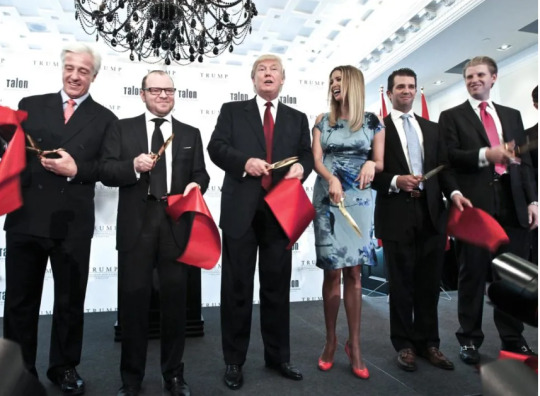
In the city’s new five-star hotel landscape, the Ritz represents elegant European classicism, the Shangri-La cool, Asian chic, and the Trump unfettered American pomp. Like its loud-mouthed namesake, the Trump is brash, proud and full of bluster. Stock, the hotel’s restaurant and bar, is outfitted with shiny tufted black leather seating and silver accents. Its lobby, a shimmering expanse of marble and mirrors, seems sprung, fully formed, from the imagination of Joan Collins.
The hotel’s developer, Talon International, is run by Val Levitan and Alex Shnaider, two Russian-Canadian entrepreneurs. Levitan made his fortune manufacturing slot machines and creating bank note validation technology, and Shnaider earned his in the post-glasnost steel trade. The Trump is their first Toronto real estate venture. In 2002, during a meeting in Shnaider’s office at Dufferin and Finch, they agreed on a plan to build the city’s biggest, fanciest, five-starriest hotel. They both travel frequently for work and agreed that Toronto’s hotels lacked the quality of the ones they stayed at in London, New York and Moscow. Back then, Toronto’s swankiest option was the old Four Seasons, a dour brutalist tower in Yorkville. But the city was emerging as a major North American financial centre, a place where serious players were coming to do big international deals. These titans were in need of boardrooms in which to meet, bloody steaks to consume, and high-thread-count sheets to sleep between.
In 2004, Talon bought a site at the corner of Bay and Adelaide for $27.4 million. The location was perfect—smack in the centre of the business district. This was before the cultural revitalization of the city’s downtown core, but Levitan and Shnaider could see the signs: the revamping of the Bay’s flagship department store, the plans for the new Bell Lightbox, not to mention a phalanx of condos and restaurants springing up in the city centre. By the time the hotel was completed, it would be the anchor point of a tourist-friendly downtown.
The luxury hotel required a famous brand, which is how the pair ended up approaching Donald Trump. At the time, Trump’s reality show The Apprentice was riding high in the ratings, and the Trump brand was associated with luxury, success and business prowess, not with headline-making Twitter spats and an aborted Republican leadership bid. They worked out a deal to license the Trump name.
They planned a 65-storey mixed-use building consisting of a restaurant and bar, a day spa, 118 condos—some as large as 4,400 square feet and selling for up to $9.1 million—and 261 “condo-hotel suites,” traditional hotel rooms that Talon intended to sell as residential real estate investments. The condo-hotel set-up was unusual in Toronto. It’s an attractive model for developers because it allows them to raise capital up front from investors.
Donald Trump is a shareholder in other Trump developments in Chicago, New York and Las Vegas, but not in Toronto. The hotel would bear his name and his style, and an affiliate of his management company would run the day-to-day hotel service. According to the early marketing brochures, it would be a model for “Manhattan-style luxury living in Toronto.”

By the time the Trump opened in 2012, ten years after the plan was hatched and more than two years later than originally scheduled, the financial climate had, of course, drastically changed. The hotel now felt like a throwback to a cockier, pre-recession era, back when hedge fund managers ruled the world and Bernie Madoff was a respected financial guru. A group of buyers now regret their investment in the building, and millions of dollars in deals between them and Talon are on the verge of collapsing. The group claims their condo-hotel units often sit empty, and they’ve launched a series of lawsuits alleging the Trump sales team misrepresented how much profit they’d make. The defendants say the lawsuits have no merit, that no misrepresentations were made. The claims have yet to be heard in court.
The Trump investors believed they’d bought into a get-rich-quick scheme. How did something so promising go so wrong?
Before there was the Trump Tower, there was the Trump tower sales office, a glass-fronted box that stood on the same prime corner from which the hotel would eventually rise. A polished young sales team sold a steady stream of units, over the phone, online and in person, to a diverse cross-section of buyers—including elderly Korean pensioners, wealthy Nigerians and a now-defunct U.K. company called WorldWide Properties, which bought four floors of hotel units with the intention of flipping them.
When the Trump broke ground, half of the residential condos had sold, as had 191 of the condo-hotel units, which ranged in price from $736,000 to $3.8 million. The suites could be rented out as part of the hotel, providing extra income to buyers. In the Trump system, occupancies are organized in a strict, computerized rotation, which ensures that the least rented room jumps to the front of the queue. The hotel charges service fees for maintenance (linens, towels, cleaning, etc.) and management, but the rest of the rental profit goes to the owner of the room. The promotional material declared that “investing in hotel suites is a trend that’s sweeping the United States… The reason? Great cash flows, no concern for maintenance and reasonable cash requirements as a down payment. Leverage is key, especially in these times of low interest rates.”
Promotions featured an airbrushed picture of Trump, along with a personal endorsement: “We’re going to do something very special in Toronto.” Trump himself, the ad said, “has an undeniably keen eye for a deal.” The ad neglected to mention that Trump wasn’t the project’s developer, just its smiling face.
Sarbjit Singh, a 49-year-old warehouse supervisor from Milton, was one of the early buyers. Singh first heard about the Trump in October 2006 from a real estate agent who told him it was a great investment opportunity. He and his wife, Kimberly, had recently bought a house and just had their second daughter. He didn’t have the money to buy another property. “I was only making between $50,000 and $60,000 a year,” he says. “I’m a regular person, not rich.”
But the prospect of getting his own piece of Trump magic proved too tempting. He claims the agents at the Trump sales centre told him he couldn’t possibly lose money since the “absolute worst case scenario” was that the hotel ended up at 55 per cent occupancy, and even then the projected returns were healthy. “I asked them a long list of questions,” he recalls. Who was going to arrange the mortgages? What would the interest rate be? Would the property be categorized as commercial or residential (commercial properties come with much higher interest rates). He alleges the sales associate assured him he had nothing to worry about. According to Singh, they said Talon was already working on financing with lenders, and it would all go smoothly. The units would qualify for residential mortgages. Singh then asked at what point he could flip the unit, and the agent told him directly after closing. “You’ll make a lot of money,” he remembers the agent telling him. “Even if you don’t sell, you’ll be making lots of money from the reservation program.”

Armed with Talon’s projection sheet, his head dancing with trust funds for his daughters, Singh went to his mother and father, who are retired and living on a pension. He convinced them to take out a $150,000 line of credit on their house, which they owned outright, so he could put down a deposit of $173,400 on an $869,000 suite. He believed, like many other investors I spoke to, that he was buying a piece of real estate directly from Donald Trump and that he couldn’t lose. “I bought it on the strength of his name alone. He’s Donald Trump—hotels and real estate are his business, not mine. I trusted that it would work.”
Construction of the Trump Tower got off to an inauspicious start. It took two years to receive planning permission from the city, and there were more delays after Talon broke ground in late 2007. Because of the site’s small footprint—15,000 square feet—only one crane could be employed at a time. Shnaider admitted it was a bit of a nightmare. “I wouldn’t do such a project again in Toronto,” he said.
More significantly for investors, the economic reality changed. As Levitan put it, “It was a very complicated project that became delayed, and in that time the economy fell apart. How can I control that?” In the new market, the projection sheets Talon had distributed with the initial sales package weren’t worth the creamy stationery they were printed on.
In March 2012, Sarbjit Singh took possession of his unit and started paying monthly fees of $8,207, which covered realty taxes, common fees and interest. He expected his rental profits to more than offset the fees, but when the first revenue statements came in, he knew something was wrong: in four months, his unit had been rented 49 times—roughly a 40 per cent occupancy rate and lower than the “absolute worst case scenario” the agent had discussed with him. Singh’s room was running at a loss. When he called hotel management, they told him the bad news: because of the dampened hotel market, they’d been renting his room out at a discounted rate. (Rooms at the Trump that were forecast to cost $550 to $600 per night have been available for $400 on Expedia.) Singh was losing approximately $5,000 a month.
His problems didn’t end there. He visited several major banks and was told the property was commercial, not residential, and thus he’d need a commercial mortgage, for which he’d need to put 50 per cent down—money he didn’t have. Even if he could find the down payment, the commercial interest rates would raise his mortgage payments beyond what he could afford to carry.
Last November, Singh ran out of reserve cash. He stopped paying his fees and is now working in the evenings and on weekends in an effort to pay his parents’ line of credit. He recently missed a mortgage payment. He has no idea how he’ll get out of debt.
Singh retained the Toronto law firm Heydary Hamilton last November and filed a suit against the developers. Another 37 buyers have also filed suits. A Heydary lawyer named Mitchell Wine, one of the team of 14 lawyers and articling students working on the Trump cases, told me purchasers and representatives of more than 100 units have contacted his office. The firm has filed statements of claim detailing each of the investors’ stories and accusing Talon and other named parties of misrepresentation, breaches of the Ontario Securities Act, breach of contract, breach of the Condominium Act and conspiracy. Each claimant is asking for well over a million dollars in damages, plus their deposit money back with interest. Pleadings are being finalized, and preliminary motions were scheduled to be heard just after this issue went to press. In response, Talon is seeking to have the action by investors dismissed.
to be continued...
1 note
·
View note